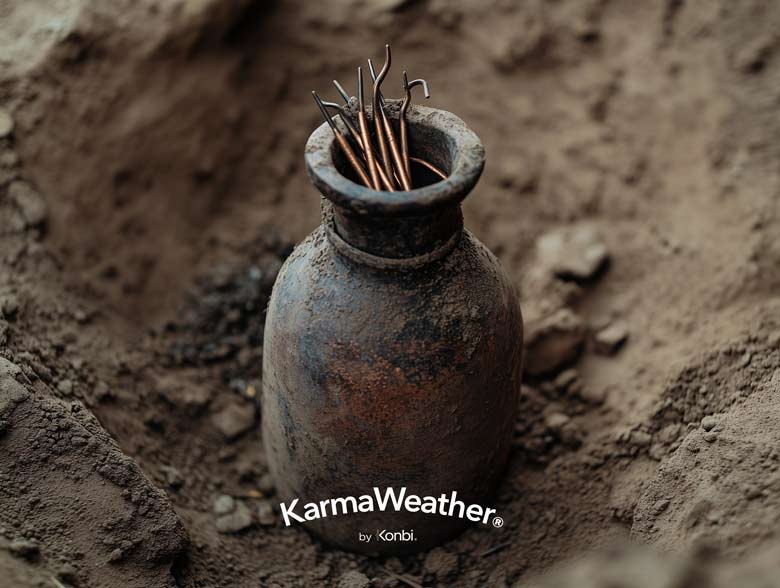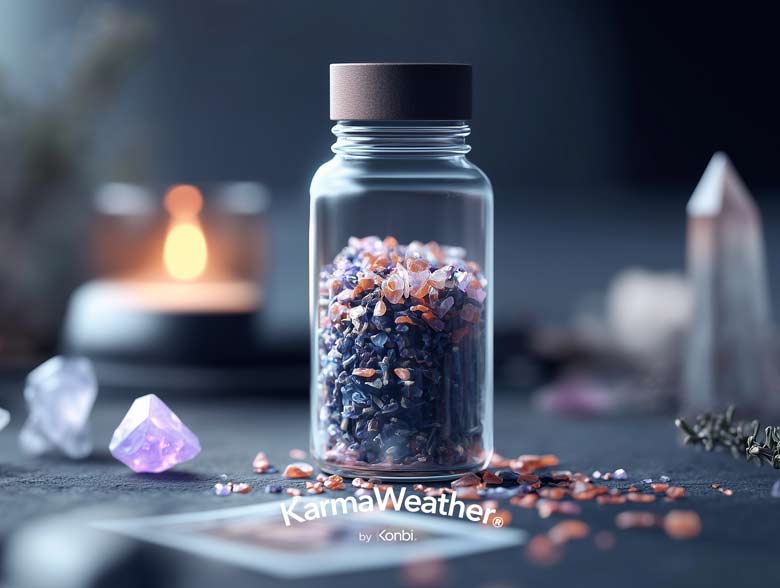Witch Bottles: Magical Protection Rituals in the 17th Century
© KarmaWeather by Konbi - All rights reserved
In the shadows of the 17th century, at the crossroads of superstition and folk magic, an enigmatic artifact emerged: the witch bottle. This modest object, sometimes crafted from decorated stoneware or blown glass, concealed far more than a simple assemblage of thorns, nails, and bodily elements.
Each component, every burial location, was carefully chosen, woven into a ritual aimed at repelling evil or trapping a malevolent entity. These bottles, marked by now-lost esoteric practices, offer a poignant testimony to humanity's struggle against the unseen forces they feared.
Far from being mere archaeological curiosities, witch bottles reveal a worldview where the boundary between the natural and the supernatural was blurred. Balancing protection and vengeance, they represented a complex response to the existential anxieties of an era when religious faith, medicine, and magic intertwined within rituals shrouded in mystery.
Origins and Context of Witch Bottles
The emergence of witch bottles dates back to a time when witchcraft, perceived as an omnipresent threat, haunted the collective psyche. In England and across certain parts of northern Europe, these vessels were designed as bulwarks against unexplained misfortunes. Falling ill, losing a harvest, or experiencing a series of unfortunate events was often enough to accuse a neighbor, frequently a marginalized woman, of practicing witchcraft.
These practices, deeply rooted in popular beliefs, also found echoes in the scholarly writings of the time. Texts such as The Astrological Practice of Physick (1671) detailed the methods associated with these rituals. They described how healers prescribed the creation of bottles to counter alleged enchantments, using a blend of bodily fluids, metal objects, and powerful symbols to establish a mystical connection between the victim and the presumed source of harm.
Witch bottles were not confined to rural settings. They were also found in urban homes, bourgeois residences, and even religious estates. Their presence transcended social classes, underscoring the universality of the fear of malevolence and the need to counter it with tangible measures.
Fabrication and Composition of Witch Bottles
Each witch bottle was a meticulously crafted ritual object, with every element embodying a specific intention. Metallic items—rusted nails, bent pins, sharp needles—symbolized spiritual weapons designed to pierce and neutralize malevolent energies. This choice, far from arbitrary, amplified their apotropaic role by symbolically imprisoning the evil, binding and rendering it powerless.
Bodily fluids, particularly urine, played a central role. They established an intimate connection between the bottle, its creator, and the supposed target. This link, derived from sympathetic magic, aimed to transfer pain or reflect harm back to its originator. Sometimes, hair, bones, fingernails, or teeth were added to strengthen this mystical connection.
The containers themselves varied. Stoneware jugs known as "Bellarmine bottles," adorned with grotesque faces, were commonly used in England. Their sturdiness and symbolism—a bearded face considered fearsome—added an apotropaic dimension. On the European continent, molded or blown glass vessels were more frequent, occasionally painted or engraved with protective motifs.

Usage and Symbolism of Witch Bottles
Witch bottles were designed to operate on multiple levels: to deflect, trap, or reverse a curse. Their burial location was strategic. Placed under hearths, they absorbed heat, a symbol of protective energy. Buried near foundations, they acted as silent sentinels guarding the home's spiritual integrity.
The use of these bottles also varied according to intent. Some aimed to neutralize alleged curses, while others sought to inflict pain on the supposed sender of the spell. In certain cases, the bottles were heated until they shattered. This sound, sometimes accompanied by a loud bang, was interpreted as a sign of the curse's dissolution.
A 17th-century chronicle recounts the intriguing tale of a desperate man advised by a healer to concoct a remedy against a supposed curse afflicting his wife. Following the instructions, he collected her urine, mixing it with nails and pins inside a carefully sealed bottle. Shortly after, his wife’s health dramatically improved. However, a grieving neighbor soon appeared, claiming the ritual had caused the death of her husband, whom she believed to be the source of the curse. This episode, as unsettling as it is revealing, illustrates the immense symbolic power attributed to these bottles, perceived as tools capable of influencing life and death in the collective imagination of the time.
Recent Archaeological Discoveries
Recent excavations have uncovered witch bottles across the globe, offering a tangible glimpse into this mysterious practice. In Rochester, England, an intact bottle containing copper nails, a human tooth, and a child’s hair was unearthed from a 17th-century pit. In Seclin, France, a similar find revealed a complex assemblage of pins, nails, and glass fragments, likely immersed in urine and buried in the grounds of an old tavern. These carefully selected elements testify to rituals aimed at fixing or deflecting malevolent influences.
Each discovery tells a unique story, shedding light on the social and spiritual practices of the time. In Seclin, the presence of a wooden bucket containing these relics suggests a carefully orchestrated ceremony, perhaps performed by a healer or community member to counteract a specific curse. In Rochester, analysis of the child’s hair found within the bottle reveals poignant connections to family life and the pervasive fear of illness or infant mortality. These artifacts, far from being mere inanimate objects, serve as open windows into the anxieties and hopes of men and women from the past.
Often broken or sealed, these bottles still hold secrets, and every new analysis, from X-rays to chemical studies, uncovers fascinating details about their content and use. They illustrate the richness of folk beliefs and show how everyday objects could become tools of spiritual resistance against unseen forces.

Modern Influence of Witch Bottles
Today, witch bottles have made a remarkable comeback, no longer as objects of fear but as instruments of introspection and spiritual exploration. In the realms of neo-paganism and contemporary witchcraft, they are reinterpreted for rituals of protection, energy balance, or purification. Social media platforms like TikTok and Instagram are brimming with modern creations where semi-precious stones, dried herbs, and essential oils replace the rusted nails and bodily fluids of historical practices.
This reinvention, while distant from 17th-century traditions, reveals a constant human need: to ritualize the world to ease uncertainties. These new bottles no longer aim to counter curses sent by invisible hands but to reinforce their creators’ inner harmony. They also reflect a renewed fascination with esoteric practices, where ancient symbolism merges with a modern quest for well-being and spirituality.
Far from being mere historical curiosities, modern witch bottles continue a long tradition of resistance against the unseen. They embody a timeless struggle to master occult forces, whether perceived as external or internal. Each new bottle, whether containing twisted pins or shimmering crystals, is part of an ongoing dialogue between past and present, mystery and the search for meaning.
